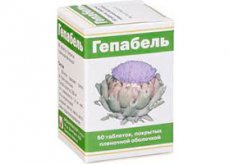Medical expert of the article
New publications
Preparations
Hepabel
Last reviewed: 04.07.2025

All iLive content is medically reviewed or fact checked to ensure as much factual accuracy as possible.
We have strict sourcing guidelines and only link to reputable media sites, academic research institutions and, whenever possible, medically peer reviewed studies. Note that the numbers in parentheses ([1], [2], etc.) are clickable links to these studies.
If you feel that any of our content is inaccurate, out-of-date, or otherwise questionable, please select it and press Ctrl + Enter.

Hepabel is used for various biliary diseases.
Indications Hepabella
It is used for the following disorders:
- dyskinesia in the biliary tract, which has a hypokinetic form;
- acalculous form of cholecystitis in the chronic stage;
- hepatitis of a chronic nature;
- liver cirrhosis;
- chronic renal failure;
- nephritis, occurring in a chronic form;
- chronic poisoning (by hepatotoxic elements, alkaloids, nitro compounds or heavy metal salts).
Release form
The medicinal component is released in tablet form, in the amount of 60 pieces inside a polypropylene jar.
Pharmacodynamics
Hepabel is of plant origin. Its therapeutic activity develops under the influence of a complex of bioactive components (such as bioflavonoids, cinnarine with glycosides, coffee and chlorogenic acid, carotene with phytosterols, enzymes, terpenoids and vitamins with inulin) contained inside the Spanish artichoke. The drug has hepatoprotective, diuretic, antioxidant, choleretic, detoxifying and hypocholesterolemic activity.
The hypocholesterolemic effect develops when the processes of cholesterol biosynthesis are slowed down (by inhibiting the activity of 3-hydroxy-3-methylglutaryl-CoA reductase).
Cinnarine, combined with phenoacids, has a choleretic activity (mainly with the participation of choleretic effect). It increases the amount of secreted bile, the release of bile salts, and in addition, prevents the likelihood of bile stagnation inside the bile duct and potentiates the release of pancreatic enzymes.
The tablets have antioxidant properties; the drug reduces lipid peroxidation by decreasing malondialdehyde levels.
The hepatoprotective effect develops as a result of the stabilizing effect on the walls of hepatocytes.
Dosing and administration
For adults, the serving size is 1 tablet 3 times a day (the medicine should be taken 20 minutes before meals). Teenagers over 12 years of age should take 1 tablet 2 times a day.
The therapeutic cycle lasts 10-20 days; if necessary, the doctor may prescribe a repeat course of treatment after 1-2 months.
 [ 1 ]
[ 1 ]
Use Hepabella during pregnancy
It is prohibited to use Hepabel during pregnancy or lactation.
Contraindications
Among the contraindications:
- the presence of hypersensitivity to elements of the drug and plants from the Asteraceae group;
- obstruction of the urethra or biliary tract;
- cholelithiasis;
- diseases affecting the bile ducts, as well as the urinary tract, liver or kidneys, and having an acute form;
- severe liver failure.
Side effects Hepabella
The use of the drug may be a factor in the development of disorders affecting the gastrointestinal tract: diarrhea (sometimes accompanied by spasms), nausea, pain in the upper abdominal area and heartburn.
People with severe sensitivity to the components of the therapeutic agent may develop signs of allergy.
Overdose
No cases of intoxication have been recorded. In case of overdose, potentiation of negative manifestations of the drug can be expected.
To eliminate the disturbances, the drug should be discontinued and gastric lavage with symptomatic procedures should be performed. The drug has no antidote.
Interactions with other drugs
The medication can reduce the effectiveness of coumarin anticoagulants (including warfarin and phenprocoumon), which is why the dosage of the latter must be adjusted.
Combination with hypocholesterolemic or hypoazotemic drugs may increase the effectiveness of these drugs.
Hepabel has a diuretic effect, increases the secretion of chloride with sodium, and in addition, can potentiate the hyperuricemic and hyperglycemic effect of drugs that increase blood glucose levels.
Storage conditions
Hepabel should be kept in a dark place, closed to small children. Temperature indicators are within the 25°C mark.
 [ 2 ]
[ 2 ]
Shelf life
Hepabel can be used within a 3-year period from the date of release of the therapeutic drug.
Application for children
The drug cannot be prescribed in pediatrics (children under 12 years of age).
 [ 3 ]
[ 3 ]
Analogues
Analogues of the medicinal substance are Rowachol, Allochol, Cynarix with Immortelle, as well as Holosas, Flamin and Hofitol.
Attention!
To simplify the perception of information, this instruction for use of the drug "Hepabel" translated and presented in a special form on the basis of the official instructions for medical use of the drug. Before use read the annotation that came directly to medicines.
Description provided for informational purposes and is not a guide to self-healing. The need for this drug, the purpose of the treatment regimen, methods and dose of the drug is determined solely by the attending physician. Self-medication is dangerous for your health.

